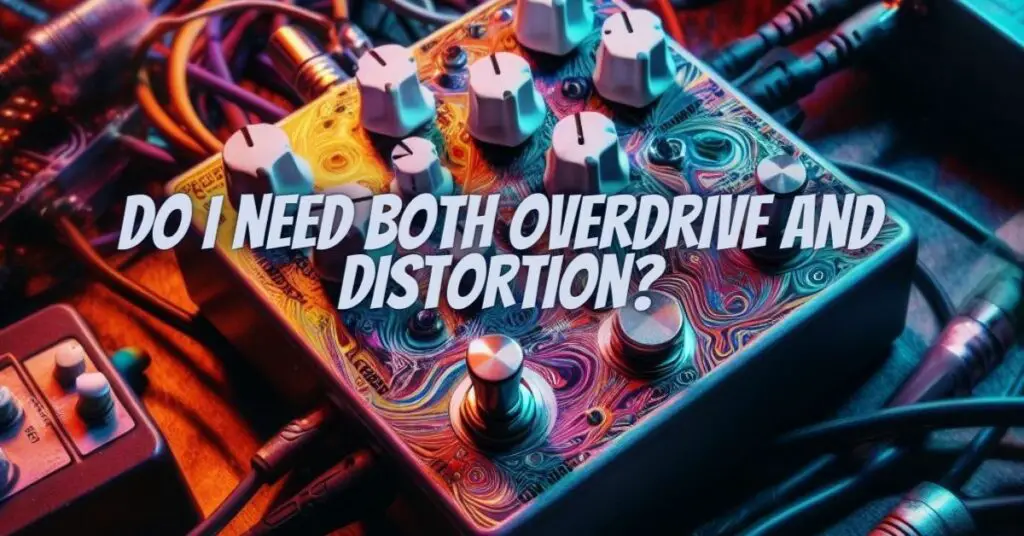Guitarists often find themselves at a crossroads when considering their pedalboard setup. Among the many choices they face, a common dilemma is whether to include both overdrive and distortion pedals. Each effect offers a distinct flavor of gain and tone, and understanding the nuances of these effects can help you make an informed decision about whether you need both on your pedalboard. This article will explore the reasons for having both overdrive and distortion pedals and how they can work together to shape your unique guitar tone.
Understanding Overdrive and Distortion Pedals
Before delving into the question of whether you need both overdrive and distortion, it’s essential to grasp the fundamental differences between these two types of pedals.
- Overdrive Pedals:
- Overdrive pedals are known for their “soft clipping” effect, which emulates the natural breakup of a tube amplifier.
- They produce warm, harmonically rich tones and are often used to add grit and sustain to a clean or slightly overdriven amp sound.
- Overdrive is prized for its sensitivity to playing dynamics, responding to changes in picking intensity with a nuanced and expressive range of tones.
- Distortion Pedals:
- Distortion pedals create a more pronounced “hard clipping” effect, introducing substantial gain and saturation.
- They are favored for their ability to transform a clean guitar signal into a heavily saturated, sometimes compressed, and sustain-rich tone.
- Distortion typically delivers a more aggressive and high-gain sound, which can be suitable for genres like hard rock and metal.
Reasons to Consider Both Overdrive and Distortion Pedals
- Tonal Versatility:
- One of the primary reasons to have both overdrive and distortion pedals is the tonal versatility they offer. Overdrive provides a smooth, medium-gain crunch, while distortion delivers a heavier, high-gain sound. Having both at your disposal enables you to cover a broader range of musical styles and tonal landscapes.
- Dynamic Expression:
- Overdrive pedals are celebrated for their sensitivity to playing dynamics, allowing you to control the level of gain and tone with your picking technique. Combining an overdrive pedal with a distortion pedal means you can switch between them to achieve a wide array of dynamic tones, from clean to heavily saturated.
- Layering Tones:
- Using both types of pedals simultaneously can yield unique results. You can start with an overdrive pedal to create a warm base tone and then engage a distortion pedal to layer on additional saturation for solos or heavy parts. This layering technique is a favorite among many professional guitarists.
- Amp Compatibility:
- The type of amplifier you have can also influence your choice. Overdrive pedals often pair well with clean or lightly overdriven tube amps, while distortion pedals can complement amps that are already driven hard. By having both on your board, you can adapt to different amp scenarios without compromising your sound.
- Creative Experimentation:
- Guitarists are inherently creative beings, and experimenting with various pedal combinations is a part of the journey. Having both overdrive and distortion pedals allows you to explore different textures and sounds, helping you develop your unique style and sound.
Examples of Pedals That Combine Overdrive and Distortion:
- Fulltone OCD (Obsessive Compulsive Drive):
- The Fulltone OCD is a renowned pedal that blends overdrive and distortion characteristics. It’s highly versatile and can cover a broad spectrum of gain levels.
- Wampler Dual Fusion:
- The Wampler Dual Fusion is designed for players who want the best of both worlds, featuring two independent channels, one for overdrive and the other for distortion.
While it’s not a strict requirement for every guitarist to have both overdrive and distortion pedals, there are compelling reasons to consider having them both on your pedalboard. The combination of these effects offers a world of tonal possibilities, creative opportunities, and adaptability to different musical situations.
Ultimately, the decision should align with your musical style, playing preferences, and the sound you wish to achieve. Whether you choose to have both pedals or opt for one over the other, remember that the essence of guitar playing lies in experimentation, personal expression, and the pursuit of your unique sonic identity.


